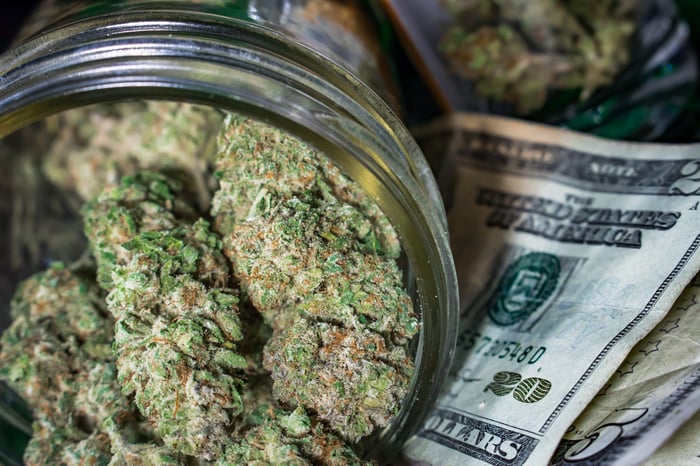On Monday, following the closing bell, Canadian cannabis grower Tilray (TLRY) released its much-anticipated fourth-quarter and full-year operating results.
With Canada officially legalizing recreational marijuana on Oct. 17, 2018, Wall Street and investors were expecting pretty much the same story they've seen throughout the industry -- i.e., higher year-over-year sales, strong consumer demand, and an outlook that speaks to continued growth. On the surface, what Tilray wound up reporting in fourth-quarter and full-year sales growth did not disappoint.

Image source: Getty Images.
Tilray's fourth-quarter sales triple, with partnership and acquisition activity picking up
For the fourth quarter, Tilray recorded $15.5 million in sales, which represents a 204% increase from the prior-year period. The company attributed the tripling in quarterly sales to the legalization of recreational weed in Canada, an uptick in exports to foreign markets, and a rise in bulk sales.
Arguably the most impressive statistic in the entire report was that 49% of the company's sales in 2018 ($43.1 million) were tied to extracts, such as cannabis oil. With states like Colorado, Washington, Oregon, and, more recently, California showing signs of dried flower oversupply and commoditization, growers that push for alternative product sales, such as oils, sublingual sprays, and in the future edibles and nonalcoholic cannabis-infused beverages will be reaping the rewards of a higher-priced and higher-margin product.
As a result of the company's focus on extracts, the average net selling price per gram increased in the fourth quarter and full year from their respective previous-year comparisons. That should be good news from a margin perspective.
Tilray's quarterly results also highlight a very active three-month period (and post quarter) with regard to partnerships and acquisitions. The company built on an already existing partnership with Novartis' generic-drug subsidiary Sandoz to supply noncombustible medical cannabis products globally; formed a $100 million joint venture with Anheuser-Busch InBev to research and develop nonalcoholic cannabis-infused beverages (which should be legal in Canada by no later than mid-October); and more recently announced the $317 million acquisition of North American hemp and natural foods producer Manitoba Harvest.
Everything might look great on the surface. But if you're even remotely a fundamentally focused investor, there's no way you could possibly support Tilray's $7 billion market cap after what you've read in its quarterly and full-year report.
Check out the latest earnings call transcript for Tilray.

Image source: Getty Images.
Sorry, folks, but there's no way Tilray deserves a $7 billion market cap
With cannabis now legal to our north, focus has begun to shift from promises to actual operating results. When it comes to Tilray's bottom line, or numerous other figures that led to its bottom-line results, the company left a lot to be desired.
For the quarter, Tilray generated a gross profit of $3.13 million, which is good enough for a gross margin of only 20%. Last year, when the company only sold $5.11 million worth of product, it managed a gross margin of 57% during the fourth quarter. Thus, even with higher-priced alternative cannabis products being sold, the company's focus on bulk sales is seriously weighing down margins in the early going.
In terms of sales, Tilray moved just 2,053 kilogram-equivalents during the fourth quarter and 6,478 kilogram-equivalents for the year. Sure, this represents a threefold increase from Q4 2017 and a doubling for the full year, but it pales in comparison to the 10,102 kilograms Canopy Growth (CGC 5.31%) sold in its fiscal third quarter or the 6,999 kilograms Aurora Cannabis (ACB 4.07%) sold in its recently reported second-quarter results. The point being that despite the third-highest market cap, Tilray sold less weed in the entire year than Canopy Growth or Aurora Cannabis did in a single quarter. And make no mistake, these are apples-to-apples comparisons on the dates over the past three months.
To add, Tilray ended 2018 with just over 850,000 square feet (domestically) devoted to cultivation, and around 250,000 square feet of grow space in overseas markets. Hypothetically speaking, without any further expansion, the company is likely hovering around 100,000 kilos in peak annual output. By comparison, Aurora Cannabis is liable to be pushing for 700,000 kilos in annual run rate by 2021, with more than 150,000 kilos in annual run rate by the end of this month. Meanwhile, Canopy Growth has over 4.3 million square feet of its 5.6 million square feet devoted to growing already licensed by Health Canada. In short, Tilray just doesn't measure up from a production standpoint.

Image source: Getty Images.
With subpar margins and unimpressive production come some pretty hefty losses. Operating losses for the fourth quarter and full year hit $22.9 million and $57.7 million, respectively, with full-year net loss per share ballooning to $0.82 from $0.10 in 2017. There's simply no indication that things are going to get better for Tilray anytime soon.
While not overlooking the value that brand-name partnerships or established medical cannabis brands bring to the table, there's just no sane way to justify the company's $7 billion valuation. If you want to dip your toes into the marijuana industry, let me make a suggestion: Cross Tilray off from your list of possible investment choices.





